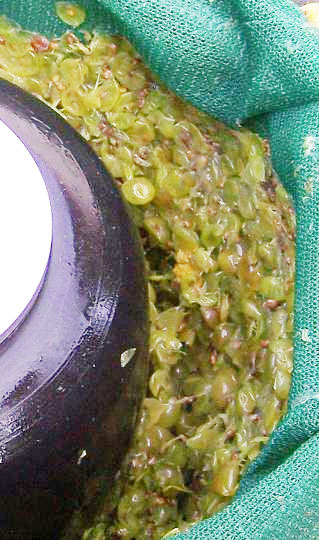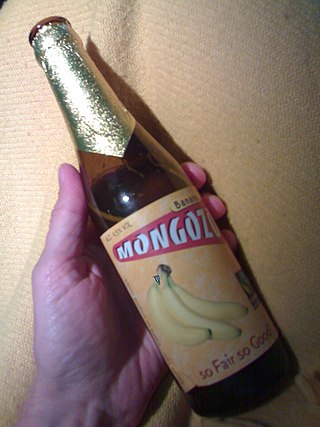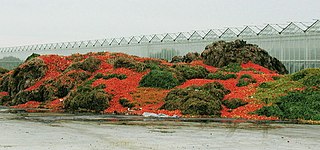
A banana is an elongated, edible fruit – botanically a berry – produced by several kinds of large herbaceous flowering plants in the genus Musa. In some countries, cooking bananas are called plantains, distinguishing them from dessert bananas. The fruit is variable in size, color, and firmness, but is usually elongated and curved, with soft flesh rich in starch covered with a rind, which may have a variety of colors when ripe. The fruits grow upward in clusters near the top of the plant. Almost all modern edible seedless (parthenocarp) bananas come from two wild species – Musa acuminata and Musa balbisiana. Most cultivated bananas are M. acuminata, M. balbisiana, or hybrids of the two.

Cooking bananas are a group of starchy banana cultivars in the genus Musa whose fruits are generally used in cooking. They are not eaten raw and generally starchy. Many cooking bananas are referred to as plantains or 'green bananas'. In botanical usage, the term "plantain" is used only for true plantains, while other starchy cultivars used for cooking are called "cooking bananas". True plantains are cooking cultivars belonging to the AAB group, while cooking bananas are any cooking cultivar belonging to the AAB, AAA, ABB, or BBB groups. The currently accepted scientific name for all such cultivars in these groups is Musa × paradisiaca. Fe'i bananas from the Pacific Islands are often eaten roasted or boiled, and are thus informally referred to as "mountain plantains", but they do not belong to any of the species from which all modern banana cultivars are descended.

Apple sauce is a purée made of apples. It can be made with peeled or unpeeled apples and can be spiced or sweetened. Apple sauce is inexpensive and is widely consumed in North America and some parts of Europe.

Salami is a cured sausage consisting of fermented and air-dried meat, typically pork. Historically, salami was popular among Southern, Eastern, and Central European peasants because it can be stored at room temperature for up to 45 days once cut, supplementing a potentially meager or inconsistent supply of fresh meat. Countries and regions across Europe make their own traditional varieties of salami.

Pomace, or marc, is the solid remains of grapes, olives, or other fruit after pressing for juice or oil. It contains the skins, pulp, seeds, and stems of the fruit.

Okara, soy pulp, or tofu dregs is a pulp consisting of insoluble parts of the soybean that remain after pureed soybeans are filtered in the production of soy milk and tofu. It is generally white or yellowish in color. It is part of the traditional cuisines of Japan, Korea, and China. Since the 20th century, it has been used in the vegetarian cuisines of Western nations.

Colombian cuisine is a compound of the culinary traditions of the six main regions within Colombia. Colombian cuisine varies regionally and is particularly influenced by Indigenous Colombian, Spanish, and African cuisines, with slight Arab influence in some regions. As one of the most biodiverse countries in the world, Colombia has one of the widest varieties of available ingredients depending on the region.

The banana leaf is the leaf of the banana plant, which may produce up to 40 leaves in a growing cycle. The leaves have a wide range of applications because they are large, flexible, waterproof and decorative. They are used for cooking, wrapping, and food-serving in a wide range of cuisines in tropical and subtropical areas. They are used for decorative and symbolic purposes in numerous Hindu and Buddhist ceremonies. In traditional homebuilding in tropical areas, roofs and fences are made with dry banana-leaf thatch. Bananas and palm leaves were historically the primary writing surfaces in many nations of South and Southeast Asia.

A banana fritter is a fritter made by deep frying battered banana or plantain in hot oil. It is a common dish across Southeast Asia and South India.

Preserved lemon or lemon pickle is a condiment that is common in the cuisines of Indian subcontinent and Morocco. It was also found in 18th-century English cuisine.

Banana beer is an alcoholic beverage made from fermentation of mashed bananas. Sorghum, millet or maize flour are added as a source of wild yeast.

A great variety of cassava-based dishes are consumed in the regions where cassava is cultivated, and the ingredient is included many national or ethnic specialities.

Vegetarian bacon, also referred to as veggie bacon, vegan bacon, vegan rashers, vacon, or facon, is a plant-based version of bacon.

Post-harvest losses of vegetables and fruit occur at all points in the value chain from production in the field to the food being placed on a plate for consumption. Post-harvest activities include harvesting, handling, storage, processing, packaging, transportation and marketing.

Tostones are twice-fried plantain slices commonly found in Latin American cuisine and Caribbean cuisine. Most commonly known as tostones in Jamaica, Puerto Rico, Mexico, Nicaragua, Cuba, U.S.A., Honduras and Venezuela, they are also known as tachinos or chatinos (Cuba), platano frito or frito verde, bannann peze (Haiti), patacones and, sometimes, patacón pisao in Colombia.

Egg substitutes are food products which can be used to replace eggs in cooking and baking. Common reasons a cook may choose to use an egg substitute instead of egg(s) include having an egg allergy, adhering to a vegan diet or a vegetarian diet of a type that omits eggs, having concerns about the level of animal welfare or environmental burden associated with egg farming, or worries about potential Salmonella contamination when using raw eggs. There is a growing movement to address some of these concerns via third-party certifications, but because many labels in the industry remain confusing or intentionally misleading, some consumers distrust them and may use egg substitutes instead.

Banana production in Ecuador is important to the national economy. Ecuador is one of the world's top banana producers, ranked 5th with an annual production of 8 million tonnes as of 2011. The country exports more than 4 million tonnes annually. The crop is mostly grown on private plantations which sell their crop to national and international companies such as Chiquita, Del Monte, Dole, and Noboa. and others.

Banana flour is a powder traditionally made of green bananas. Historically, banana flour has been used in Africa and Jamaica as a cheaper alternative to wheat flour. It is now often used as a gluten-free replacement for wheat flours or as a source of resistant starch, which has been promoted by certain dieting trends such as paleo and primal diets and by some recent nutritional research. Banana flour, due to the use of green bananas, has a very mild banana flavor raw, and when cooked, it has an earthy, nonbanana flavor; it also has a texture reminiscent of lighter wheat flours and requires about 25% less volume, making it a good replacement for white and white whole-wheat flour.

The banana industry is an important part of the global industrial agrobusiness. About 15% of the global banana production goes to export and international trade for consumption in Western countries. They are grown on banana plantations primarily in the Americas.






















